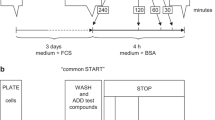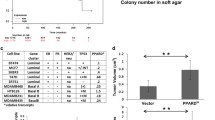Abstract
We investigated the effect of hypoglycemic treatment on the activation of the AP-1 transcription factors and the regulation of basic fibroblast growth factor (bFGF) gene expression in multidrug resistant human breast carcinoma MCF-7/ADR cells. Northern blot and gel mobility shift assays showed that hypoglycemic treatment induced c-jun and c-fos gene expression, AP-1 binding activity, as well as bFGF gene expression. Moreover, transfected cells expressing high levels of abnormal c-Jun protein exhibited a reduction in the bFGF protein levels compared to parental cells. A potent protein kinase C (PKC) inhibitor, H-7 (60 μg/ml) suppressed the stress-induced bFGF gene expression. Our study also demonstrated that H-7 did not facilitate the decay of bFGF mRNA. Thus, the suppression of bFGF gene expression by treatment with H-7 was due to the effect of the drug on the synthesis of bFGF mRNA rather than the stability of bFGF mRNA. Our data suggest that hypoglycemia-induced bFGF gene expression is mediated through the activation of PKC and the AP-1 transcription factors. (Mol Cell Biochem 155: 163–171, 1996)
Similar content being viewed by others
References
Gimbrone MAR, Leapman SB, Cotran RS, Folkman J: Tumor dormancy in vivo by prevention of neovascularization. J Exp Med 136: 261–276, 1972
Folkman J, Klagsbrun M: Angiogenic factors. Science 235: 442–447, 1987
Friesel R, Burgess WH, Mehlam T, Maciag T: The characterization of the receptor for endothelial cell growth factor by covalent ligand attachment. J Biol Chem 261: 7581–7584, 1986
Plate KH, Breier G, Millauer B, Ullrich A, Risau W: Up-regulation of vascular endothelial growth factor and its cognate receptors in a rat glioma model of tumor angiogenesis. Cancer Res 53: 5822–5827, 1993
Millauer B, Shawver LK, Plate KH, Risau W, Ullrich A: Glioblastoma growth inhibited in vivo by dominant-negative Flk-1 mutant. Nature 367: 576–579, 1994
Winkles JA, Peifley KA, Friesel RE: Tumor promoters induce basic fibroblast growth factor gene expression in human dermal fibroblasts. Cancer Res 52: 1040–1043, 1992
Witte L, Fuks Z, Haimovitz-Friedman A, Vlodavsky I, Goodman DWS, Elder A: Effects of irradiation on the release of growth factors from cultured bovine, porcine, and human endothelial cells. Cancer Res 49: 5066–5072, 1989
Haimovitz-Friedman A, Vlodavsky I, Chaudhuri A, Witte L, Fuks Z: Autocrine effects of fibroblast growth factor in repair of radiation damage in endothelial cells. Cancer Res 51: 2552–2558, 1991
Shing Y, Folkman J, Haudenschild C, Lund D, Crum R, Klagsbrun M: Angiogenesis is stimulated by a tumor-derived endothelial cell growth factor. J Cell Biochem 29: 275–287, 1985
Klagsbrun M, Sasse J, Sullivan R, Smith JA: Human tumor cells synthesize an endothelial cell growth factor that is structurally related to basic fibroblast growth factor. Proc Natl Acad Sci USA 83: 2448–2452, 1986
Soutter AD, Nguyen M, Watanabe H, Folkman J: Basic fibroblast growth factor secreted by an animal tumor is detectable in urine. Cancer Res 53: 5297–5299, 1993
Kim SJ, Glick A, Sporn MB, Roberts AB: Characterization of the promoter region of the human transforming growth factor-1 gene. J Biol Chem 264: 402–408, 1989
Kim SJ, Denhez F, Kim KY, Holt JT, Sporn MB, Roberts AB: Activation of the second promoter of the transforming growth factor-β1 gene by transforming growth factor-β1 and phorbol ester occurs through the same target sequences. J Biol Chem 264: 19373–19378, 1989
Shibata F, Baird A, Florkiewicz RZ: Functional characterization of the human basic fibroblast growth factor gene promoter. Growth Factors 4: 277–287, 1991
Angel P, Hattori K, Smeal T, Karin M: The c-jun proto-oncogene is positively autoregulated by its product, Jun/AP-1. Cell 55: 875–885, 1988
Deng T, Karin M: JunB differs from c-Jun in its DNA-binding and dimerization domains, and represses c-Jun by formation of inactive heterodimers. Genes Dev 7: 479–490, 1993
Binetruy B, Smeal T, Karin M: Ha-ras augments c-Jun activity and stimulates phosphorylation of its activation domain. Nature 351: 122–127, 1991
Boyle WJ, Smeal T, Defize LH, Angel P, Woodgett JR, Karin M, Hunter T: Activation of protein kinase C decreases phosphorylation of c-Jun at sites that negatively regulate its DNA-binding activity. Cell 64: 573–584, 1991
Andrews GK, Harding MA, Calvet JP, Adamson ED: The heat shock response in HeLa cells is accompanied by elevated expression of the cfos proto-oncogene. Mol Cell Biol 7: 3452–3458, 1987
Bukh A, Martinez-Valdez H, Freedman SJ, Freedman MH, Cohen A: The expression of c-fos, c-jun and c-myc genes is regulated by heat shock inhuman lymphoid cells. J Immunol 144: 4835–4840, 1990
Angel P, Rahmsdorf HJ, Poting A, Herrlich P: c-fos mRNA levels in primary human fibroblasts after arrest in various stages of the cell cycle. Cancer Cells 3: 315–319, 1985
Hollander MC, Fornace AJ, Jr: Induction of fos RNA by DNA-damaging agents. Cancer Res 49: 1687–1692, 1989
Stein B, Angel P, van Dam H, Ponta H, Herrlich P, van Der Eb A, Rahmsdorf HJ: Ultraviolet-radiation induced c-jun gene transcription: two AP-1 like binding sites mediate the response. Biochem Photobiol 55: 409–4215, 1992
Sherman ML, Datta R, Hallahan DE, Weichselbaum RR, Kufe DW: Ionizing radiation regulates expression of the c-jun protooncogene. Proc Natl Acad Sci USA 87: 5663–5666, 1990
Hallahan DE, Sukhatme VP, Sherman ML, Virudachalam S, Kufe D, Weichselbaum RR: Protein kinase C mediates x-ray inducibility of nuclear siganl transducers EGR1 and JUN. Proc Natl Acad Sci USA 88: 2156–2160, 1991
Shibanuma M, Kuroki T, Nose K: Stimulation by hydrogen peroxide of DNA synthesis, competence family gene expression and phosphorylation of a specific protein in quiescent Balb/3T3 cells. Oncogene 5: 1025–1032, 1990
Piette J, Hirai S-l, Yaniv M: Constitutive synthesis of activator protein 1 transcription factor after viral transformation of mouse fibroblasts. Proc Natl Acad Sci USA 85: 3401–3405, 1988
Hallahan DE, Gius D, Kuchibhotla J, Sukhatme V, Kufe DW, Weichselbaum RR: Radiation signaling mediated by Jun activation following dissociation from a cell type-specific repressor. J Biol Chem 268: 4903–4907, 1993
Erdos G, Lee YJ, Cho JM, Corry PM: Heat-induced bFGF gene expression in the absence of heat shock element correlates with enhanced AP-1 binding activity. J Cell Physiol, in press.
Tushinski R, Sussman P, Yu L, Bancroft F: Pregrowth hormone messenger RNA: glucocorticoid induction and identification in rat pituitary cells. Proc Natl Acad Sci USA 74: 2357–2361, 1977
Lehrach H, Diamond L, Wozney J, Boedtker H: RNA molecular weight determinations by gel electrophoresis under denaturing conditions, a critical reexamination. Biochemistry 16: 4743–4751, 1977
Bradford MM: A rapid and sensitive method for the quantitation of microgram quantities of protein utilizing the principle of protein-dye binding. Anal Biochem 72: 248–254, 1976
Walker JM: Gradient SDS polyacrylamide gel electrophoresis. In: J.M. Walker (ed.), Methods in Molecular Biology, Vol. 1, pp. 57–61. Clifton, NJ: Humana Press, 1984
Baichwal VR, Tjian R: Control of c-Jun activity by interaction of a cell-specific inhibitor with regulatory domain differences between v- and c-Jun. Cell 63: 815–825, 1990
Mergia A, Eddy R, Abraham JA, Fiddes JC, Shows TB: The genes for basic and acidic fibroblast growth factors are on different human chromosomes. Biochem Biophys Res Commun 138: 644–651, 1986
Florkiewicz RZ, Sommer A: Human basic fibroblast growth factor gene encodes four polypeptides: Three initiate translation from non-AUG codons. Proc Natl Acad Sci USA 86: 3978–3981, 1989
Devary Y, Gottlieb RA, Lau LF, Karin M: Rapid and preferential activation of the c-jun gene during the mammalian UV response. Mol Cell Biol 11: 2804–2811, 1991
Datta R, Hallahan DE, Kharbanda SM, Rubin E, Sherman ML, Huberman E, Weichselbaum RR, Kufe DW: Involvement of reactive oxygen intermediates in the induction of cjun gene transcription by ionizing radiation. Biochemistry 31: 8300–8306, 1992
van Dam H, Duyndam M, Rottier R, BoschA, de Vries-Smits L, Herrlich P, Zantema A, Angel P, and van der Eb AJ: Heterodimer formation of c-Jun and ATF-2 is responsible for induction of c-Jun by the 243 amino acid adenovirus E1A protein. EMBO J 12: 479–487, 1993
Herr I, van Dam H, Angel P: Binding of promoter associated AP-1 is not altered during induction and subsequent repression of the c-jun promoter by TPA and UV irradiation. Carcinogenesis 15: 1105–1113, 1994
Devary Y, Gottlieb RA, Smeal T, Karin M: The mammalian ultraviolet response is triggered by activation of Src tyrosine kinases. Cell 71: 1081–1091, 1992
Pulverer BJ, Kyriakis JM, Avruch J, Nikolakaki E, Woodgett JR: Phosphorylation of c-Jun mediated by MAP kinases. Nature 353: 670–674, 1991
Smeal T, Binetruy B, Mercola DA, Birrer M, Karin M: Oncogenic and transcriptional cooperation with Ha-Ras requires phosphorylation of c-Jun on serines 63 and 73. Nature 354: 494–496, 1991
Smeal T, Binetruy B, Mercola D, Grover BA, Heidecker G, Rapp UR, Karin M: Oncoprotein-mediated signalling cascade stimultes c-Jun activity by phosphorylation of serines 63 and 73. Mol Cell Biol 12: 3507–3513, 1992
Abdel-Hafiz HAM, Heasley LE, Kyriakis JM, Avruch J, Kroll DJ, Johnson GL, Hoeffler JP: Activating transcription factor-2 DNA-binding activity is stimulated by phosphorylation catalyzed by p42 and p54 microtubule-associated protein kinases. Mol Endocrinol 6: 2079–2089, 1992
Busslinger M, Bergers G: Identification of AP-1-regulated genes. In: P.E. Angel and P.A. Herrlich (eds.). The FOS and JUN Families of Transcription Factors, pp97–113. Boca Raton, Florida: CRC Press, 1994
Author information
Authors and Affiliations
Rights and permissions
About this article
Cite this article
Galoforo, S.S., Berns, C.M., Erdos, G. et al. Hypoglycemia-induced AP-1 transcription factor and basic fibroblast growth factor gene expression in multidrug resistant human breast carcinoma MCF-7/ADR cells. Mol Cell Biochem 155, 163–171 (1996). https://doi.org/10.1007/BF00229313
Received:
Accepted:
Issue Date:
DOI: https://doi.org/10.1007/BF00229313




